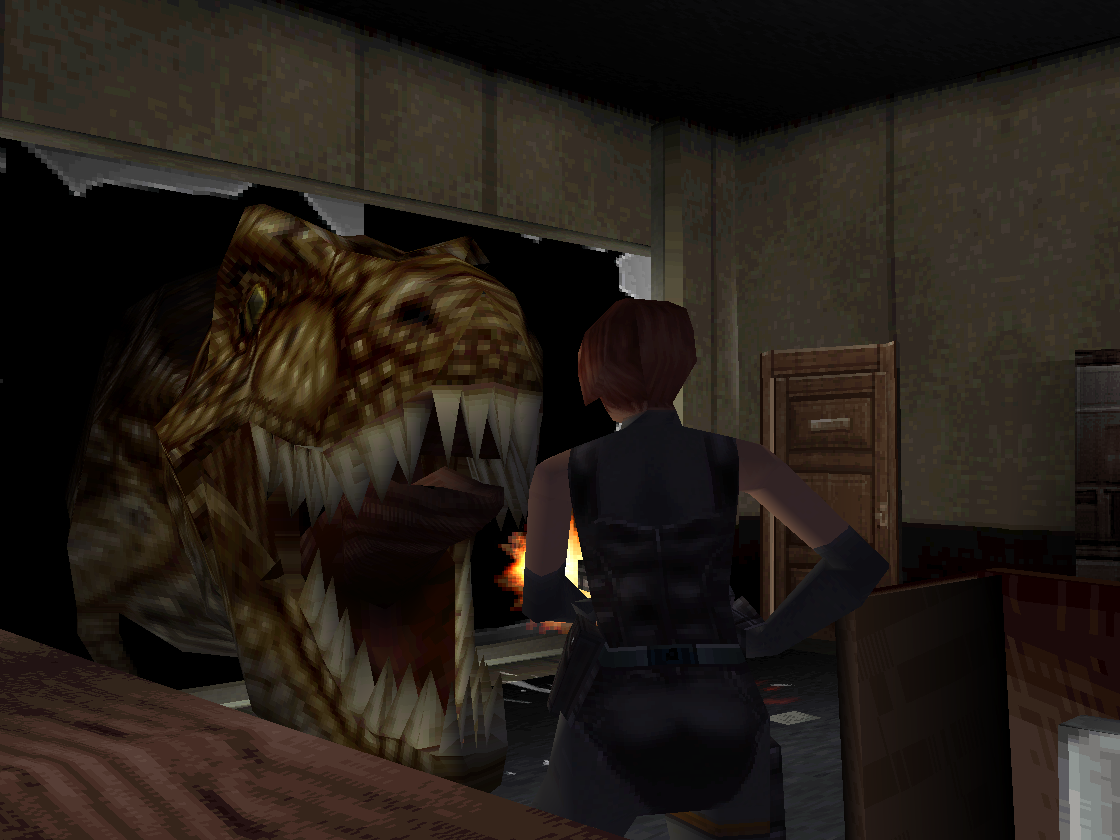
The “survival horror” genre has pretty much been defined by saying “it’s like Resident Evil.” While some gamers have been expecting the well to run dry in terms of subject matter for these games, Dino Crisis proves that — with a little imagination and the same developer as Resident Evil — there’s some life left in the genre yet.
As Regina, a member of a military team sent to recover a scientist from a secret island base, you find that the island harbors more than just the scientist. In fact, the place is crawling with living, breathing dinosaurs. Hmmm…a secluded island base with dinosaurs and a mad scientist? Sound familiar, Michael Crichton fans?
As much as it sounds like a Jurassic Park rip-off, the game’s plot provides many opportunities for jump-inducing scare tactics. As creepy as the Resident Evil games were, the jumps weren’t as prevalent as they were during my Dino Crisis sessions. Some of the scares may seem cheap, but they’re still quite effective.
Even though the game shares more than a few similarities with the Resident Evil series (same developer, same genre, and, for the most part, the same control scheme), it differs in many key ways. First, its puzzles are a bit more logical. Second, the backgrounds are fully three-dimensional, rather than pre-rendered. Third, due to the 3D graphics as well as faster loading times, Dino Crisis is more exciting. Plodding zombies can’t compete with swift velociraptors in the sheer excitement category.
The game begins with four soldiers being air-dropped onto the island base of Dr. Kirk, a scientist who’s been presumed dead. The objective of their mission is to retrieve Dr. Kirk and get off the island. Right from the start, things go wrong. One of the team gets separated from the others and gets eaten by a T-Rex. The remaining three members find the island base seemingly deserted. While investigating the base, one of the team members is severely injured, and presumed killed, by a velociraptor. Regina and the computer expert of the team, Rick, are left to solve the mystery of the deserted base and, hopefully, escape with their lives.
The game-play is linear, but does provide a few points where your decisions affect the outcome of the game. There are several possible endings, so there is a bit of control over the final outcome.
One definite improvement over the Resident Evil series is the elimination of the typewriter-ribbon save system. In Dino Crisis, you save the game in designated “save rooms” which simply ask you if you want to save the game when you exit them. There’s no ribbon management to worry about. Also, Regina can carry a lot more items than was possible in the Resident Evil games. Items can also be stored in various places throughout the game in “emergency boxes.”
The 3D environments allow the game to be more atmospheric and movie-like than the Resident Evil series. For example, as Regina walks down a lonely corridor, it’s not unusual for the camera view to suddenly swing to a bird’s eye view as the music becomes more moody. It doesn’t necessarily mean something is going to happen, but it does heighten the suspense. When things do happen, it’s frequently with little warning or other tip-off. The active camera is very effective in maintaining the feeling of imminent danger and gives the game a definite cinematic quality.
The graphics, while a bit pixelated in places, are still pretty good. Regina’s movements are realistic enough and the dinosaurs, for the most part, look great. The velociraptors, in particular, look fantastic as they stalk around looking for their next meal and, usually, that means you.
The sound effects are also top-notch. The music, in concert with the camera, provides much in the way of eerie atmospherics. The dinosaurs sound as they do in most dinosaur movies, so that’s good. Since we’ll never know what dinosaurs actually sounded like, it’s hard to say if the sounds are accurate or not. Compared to the Jurassic Park movies, for example, they sound pretty damn good. Even the voice acting, which is notoriously bad in previous Capcom horror games, is fairly decent. There’s nothing as embarrassing as the infamous “master of unlocking” here. The script is clichéd, but still head-and-shoulders above many other games with dialogue.
If you’ve played Resident Evil, you know how to control this game. It’s virtually identical, save for a new 180° spin move that’s available by pressing the R2 button. Regina also has the ability to walk with her weapon of choice drawn and ready, so no time is wasted by having to pull the weapon out before blasting something. If you haven’t played Resident Evil, the control will take a bit of getting used to, but, once learned, it’s easily recalled. Unfortunately, the game does not allow the use of the analog sticks on the Dual Shock controller. Vibration is present, but the analog doesn’t work. It’s a shame, because it would make controlling Regina a lot easier.
Personally, I enjoyed Dino Crisis a lot more than the Resident Evil games. The puzzles, while still a bit on the cryptic side, were a lot more logical than anything found in the Resident Evil series. The speed of the game was also a big part of the game being so easy to get into. When walking from one room to another, it was a matter of a second or two before the next room opened up. The active camera added a cool dynamic feeling to each room as well. Dino Crisis just seemed a lot more polished.
If you’re in the market for an action/adventure game, Dino Crisis may be just what you’re looking for. If you’re a Resident Evil addict looking for a fix before Nemesis and Code Veronica hit the streets, this is the game for you. (And it includes a demo of Resident Evil 3: Nemesis to further entice you!)
9 out of 10.

